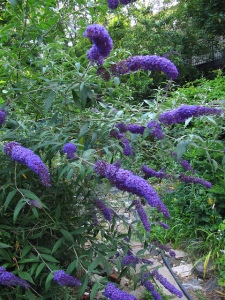Genus: Buddleja (or Buddleia)
Spieces: Buddleja davidii
Common name: butterfly bush, summer lilac, orange eye Swedish name: fjärilsbuske, syrenbuddleja
The Buddleja genus includes about hundred species of flowering plants endemic to Asia, Africa, and America. The flowers are generally rich in nectar and often strongly honey-scented. Therefor attracting butterflies, bees and moths. Buddleja davidii is one of the most used cultivates in gardens it descends from central China. It is a great coloniser of dry open ground since it self-sows. Buddleja davidii may become invasive in some regions of USA and UK. It is banned in certain areas and other species are recommended to use. There are also some cultivars with sterile seeds to choose from. Due to its likeness to spread it also inhabited urban bomb sites in the aftermath of World War II. This gave it the less flattering nickname ‘the bombsite plant’.

Buddleja davidii. Photo: Kristine Paulus ©
Description: Buddleja davidii is a vigorous shrub with an arching habit. It is frost sensitive and often the old plant parts (last year´s growth) are killed during the winter in temperate areas like Sweden. This is not a problem if the roots survive since it is fast growing and younger wood is more floriferous. There is a wide range of varieties where ‘Black Night’, ‘Nahno Blue’ (small variety), ‘White Profusion’ are some of the more common.
How to grow: Buddleja davidii prefers warm, nutritious soil rich in compost or mould with good drainage. Dry or heavy soils does not suit it. Place it in a sunny and protected spot in the garden. To encourage new growth the shrub is usually hard-pruned in spring once frosts have finished. To avoid spreading of seeds and prolong the blossom over-bloomed flower panicles are pruned. In areas with cold frosty winters you should cover the basal parts with soil, leaves or hay to protect the roots.
Crafting tips: If you love butterflies Buddlejas are one of those plants you have to get. To help the butterflies even more there are some crafts you can do to invite them.
- Butterfly restaurant
- Butterfly hotel
- Butterfly water bar (you may exclude the sugar and just use water)
© The photo is licensed by Creative Commons and some rights are reserved. License Attribution 2.0



Nice deep color. Too bad they are not New Zealand.
LikeLike
Maybe there is some native plant much alike it. But I guess you have many lovely flowers to choose from.
LikeLike
Just beautiful! Thanks for this post–I’m going to plant one of these this year. You’ve increased the chances that it will survive 🙂
LikeLike
Thank you – I am sure it will thrive! I am glad you are going to grow it. You will not be disappointed 🙂
LikeLike
We have one of these. I had no idea that it was invasive. I’m curious about the one we have, because it doesn’t expand or grow – it stays planted in one spot. I’m counting on that, because I want to move it and I worry about if it’ll survive being transplanted. I think it will 🙂
LikeLike
I guess yours is suitable for where you live since it haven´t spread. So don´t worry about an invasion of Buddlejas 🙂 If you are going to transplant it do it in the autumn or early spring. If it got much foliage it might be necessary to prune it to minimize transpiration. During the first year after moving it you should water it. Good luck!
LikeLike
This is one of my absolute favorite bushes.
LikeLiked by 1 person
It is pretty 🙂
LikeLike
We had one of these in my old neighborhood and when the kids were little we would walk to see all the butterflies!
LikeLiked by 1 person
It sounds like a pleasant memory!
LikeLike
Lovely, but I think I may be in one of the areas where it’s invasive! Of course, I’m just admiring your plants this month, as I try to keep my garden primarily planted with natives (in part for their own sake, and in part because natives don’t require watering. And water is a scarce commodity in California just now).
LikeLike
I have read about the water issue in California. You are doing the right thing to choose native and draught tolerant plants. I hope you get some rain soon!
LikeLike
I love butterfly bushes. I have them all around my house. Last summer I planted a petite butterfly bush and I hope it made it through the winter – can’t tell yet. I had lost some of other ones the year before (as did many people in my area) due to the extreme cold. I didn’t realize they had so many names. Thanks for sharing this interesting information.
LikeLike
Thank you Marla! Your garden sounds lovely. I really hope your shrubs survived. It is always sad when they don´t. I am thinking of buying a petite butterfly bush for my balcony this year.
LikeLike
I always wanted a butterfly garden! 🙂 I like the pretty blue.
@TarkabarkaHolgy from
Multicolored Diary – Epics from A to Z
MopDog – 26 Ways to Die in Medieval Hungary
LikeLike
Butterflies are like jewelry in the garden. I have always dreamt of a wild life garden. And the buddleja is one of my favorite shrubs. You get the blossom and the butterflies – can´t be better 🙂
LikeLike
Now those DO grow in Australia, but I’ve never heard them called Bombsite plants. I love the butterfly crafts. When I get the vegie garden up and running I’m definitely going to add at least one of those. BUt my neighbour keeps bees… hope they get on!
Wendy at Wendy of The Rock
LikeLike
I guess the bombsite name only was used in the time directly after the war.
Lucky you having a bee-keeper next door. Great idea to create some butterfly crafts to support both wildlife and get more pollinators to your garden. I would love to see your veggie garden when it´s in its prime!
LikeLike